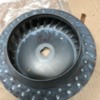.
I really have nothing against serpentine belt tensioners, or any other modern improvement that solves a problem.
I'd just advise to try checking a little to make sure there really is a problem first. (Besides, I'm basically lazy.)
And no, I don't think you should let the belt slip at high revs to save the fan. Here, the modern fix (welding the fan blades) makes more sense to me. My belt doesn't slip at any speed, and yes, my blades are welded. Of course, you've got to check belt tension regularly, along with a lot of other stuff on these cars.
Thing is, despite these being fundamentally simpler machines than modern cars, ironically, they already require quite a bit more maintenance time and attention than modern cars, so adding more gizmos is likely to just increase your workload, longterm.
Fr'instance:
I spent most of yesterday replacing the cover glass on one of my headlights after a stone from a passing gravel truck and I tried to occupy the same space at the same time.
The reason why this took a whole day maybe partly explains why these 'simple' cars take so much time to maintain.
As best I can tell, the headlight bucket and its associated 642 separate parts was probably one of those genius designs that allowed a tricky task to be performed with simple, cheaply made parts. You have to be able to adjust the position of a headlight inside a weatherproof housing from outside the housing, using tools as simple as a screwdriver. Everything is made from sheet metal, and wire parts. No castings or expensive materials. In its original German configuration it probably worked a treat — every spring, every lever, every slot, groove, and gasket perfectly formed to mesh smoothly.
What we have today is a cacophony of too cheaply made parts that look like the originals but don't fit or function like them. So it took me a day of polishing, filing, modifying, soldering, re-engineering and cursing to get the damned thing back together in a way that works somewhat like the original did.
Our cars are like this from one end to the other. For all their computers and engineering complexity, modern cars just work a lot more reliably because they are produced in quantities that require it. If headlights and other gear were as vulnerable and as cranky as this on a modern car, the cost of warranty repairs could sink a major auto maker.
So, back to my point, if we already have our hands full with 'routine' maintenance, why add to that burden if we don't have to. Any after market gizmo we add is sure to be made in minuscule quantities compared to parts for 'real' cars, at the lowest possible manufacturing cost, and without the QC that, say, Toyota would be requiring of any of its suppliers.
I'd try moving a shim before installing something new and wonderful.
.



